Silencer (firearms)
A silencer, also known as a sound suppressor, suppressor or sound moderator, is a muzzle device that reduces the acoustic intensity of the muzzle report (sound of gunfire) and eliminates muzzle flash when a gun (firearm or air gun) is discharged, by modulating the speed and pressure of the gas ejection from the muzzle and hence suppressing the muzzle blast. Like a muzzle brake, a silencer can be a detachable accessory mounted separately onto the muzzle, or an integral part of the barrel.

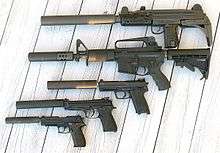
A typical silencer is a metal cylinder with internal sound baffles that slow and cool the escaping propellant gas, dissipating its kinetic energy over a longer time and over a larger area, thus reducing the blast intensity and decreasing both the sound volume and recoil impulse generated during shooting.[1] A flash suppressor, on the other hand, specifically cools or disperses burning gases which typically already exited the muzzle of a carbine-length weapon to reduce the amount of flash, without reference to sound reduction.
History
American inventor Hiram Percy Maxim, son of Maxim gun inventor Hiram Stevens Maxim and co-founder of the American Radio Relay League, is usually credited with inventing and selling the first commercially successful silencer around 1902, receiving a patent for it on March 30, 1909.[2][3][4] Maxim gave his device the popularly trademarked name "Maxim Silencer",[5] and they were regularly advertised in sporting goods magazines.[6] The muffler for internal combustion engines was developed in parallel with the firearm silencer by Maxim in the early 20th century, using many of the same techniques to provide quieter-running engines, and in many English-speaking countries automobile mufflers are called silencers.[7]
Former president of the United States Theodore Roosevelt was known to purchase and use Maxim Silencers.[8]
Silencers were regularly used by agents of the United States Office of Strategic Services, who favored the newly designed High Standard HDM .22 LR pistol during World War II. OSS Director William Joseph "Wild Bill" Donovan demonstrated the pistol for President Franklin D. Roosevelt at the White House. According to OSS research chief Stanley Lovell,[9] Donovan, an old and trusted friend of the President, was waved into the Oval Office, where Roosevelt was dictating a letter. While Roosevelt finished his message, Donovan turned his back and fired ten shots into a sandbag he had brought with him, announced what he had done and handed the smoking gun to the astonished president.[10] The British Special Operations Executive (SOE) Welrod pistol with an integral silencer was also used by the American OSS on clandestine operations in Nazi-occupied Europe.[11]
Terminology
The US National Firearms Act (NFA) of 1934 defined silencers and established regulations limiting their sale and ownership.[12] Both the US Department of Justice and the Bureau of Alcohol, Tobacco, Firearms and Explosives (ATF) use the term silencer.[13] Hiram Percy Maxim, the original inventor of the device, marketed them as "Maxim Silencers".[14]
The earliest use of the technical term suppressor to refer to firearm noise reduction is in US Patent 4530417, July 23, 1985, "A suppressor for reducing the muzzle blast of firearms or the like".[15] In UK English, silencer is the common term for either a motor vehicle muffler or for a gun silencer.[7] Sound moderator has been used in UK English for silencers on high-powered rifles used for hunting or at ranges.[16][17]
The Oxford, American Heritage, and other dictionaries apply the term suppressor to such contexts as electromagnetic shielding devices, genetics, and censorship, but not firearms.[18][19][20][21] These dictionaries define both silencer and suppressor as essentially equivalent and interchangeable, neither applying exclusively or primarily to sound, and both being applicable as much to complete and total quiet or to partial reduction of sound.[18][19][20][21]
In 2011, the US National Rifle Association began a campaign to increase the civilian use of silencers for hunting and sport shooting, setting the goals of easing the restrictions in the Federal NFA of 1934, and in various state laws, regulating the sale and ownership of firearm silencers. In the same year, the American Silencer Association (ASA) was founded by US manufacturers of silencers, with the same goals of moving silencers into the mainstream.[22][23] Along with state and federal legislative lobbying efforts, the NRA and ASA began public information campaigns designed to change the perception of silencers from their association with espionage, assassination, crime or military special operation use, to instead show that silencers can have health and safety benefits, primarily protecting the hearing of shooters and people in the vicinity, and to debunk the perceived myth in popular television, film and video game media that silencers are so effective that gunshot sounds can go totally unnoticed, such as by people in the next room of a building.[24][22][25]
In 2014, the ASA changed its name to American Suppressor Association "in a continuing effort to dispel myths about suppressors".[26] Gun control advocates have said that changing the name from "silencer" to "suppressor" is semantic propaganda similar to the efforts to avoid terms like "assault rifle" or "assault weapon" in favor of friendlier-sounding language like "modern sporting rifle", while gun rights advocates make essentially the opposite argument, and also that the widespread term silencer reflects technical ignorance and is poorly defined.[23][25]
Gun rights advocates and gun media generally say that the word "silencer" is defined as meaning total silence, while "suppressor" is defined as only meaning reduced sound intensity.[23][25]
Firearm noise anatomy
When discharged, a firearm makes sound from three sources:
- Muzzle blast — shockwave generated by high-pressure gases escaping and expanding from the muzzle after the projectile exits the barrel and breaks the functional seal restraining the gas inside the bore
- Sonic boom — sharp bullwhip-cracking sound associated with high-frequency shockwaves caused by an object (in this case, the bullet) flying supersonically through the air
- Mechanical noise generated by the internal moving parts of the firearm action
A silencer can only affect the noise generated by the muzzle blast.
While using subsonic ammunitions can negate the sonic boom, mechanical noise can be mitigated but is nearly impossible to eliminate. For these reasons, it is difficult to completely silence any firearm, or achieve an acceptable level of noise suppression in revolvers. Revolvers have a looser gas seal between the barrel and the cylinder that emits noise from escaping gasses. Some revolver designs attempt to overcome this, such as the Russian Nagant M1895 and OTs-38, and the US S&W QSPR.
Muzzle blast generated by firearm discharge is directly proportional to the amount of propellant to be combusted within the cartridge. Therefore, the greater the case capacity (e.g. a magnum cartridge), the louder the muzzle blast and consequently a more efficient or larger silencer system is required. A gunshot (the combination of the sonic boom, the vacuum release, and hot gases) will almost always be louder than the sound of the action cycling of an autoloading firearm. Alan C. Paulson, a renowned firearms specialist, claimed to have encountered an integrally suppressed .22 LR gun that had such a quiet report ,[27] although this is somewhat uncommon. Properly evaluating the sound generated by a firearm can only be done using a decibel meter in conjunction with a frequency spectrum analyzer during live tests.
Design and construction
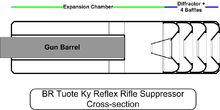


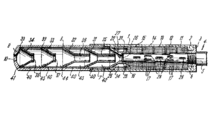
The silencer is typically a hollow metal tube manufactured from steel, aluminum, or titanium and contains expansion chambers. This device, typically cylindrical in shape, attaches to the muzzle of a pistol, submachine gun, or rifle. Some "can"-type silencers (so-called as they often resemble a beverage can) may be detached by the user and attached to a different firearm. Another type is the "integral" suppressor, which typically consists of an expansion chamber or chambers surrounding the barrel. The barrel has openings or "ports" which bleed off gases into the chambers. This type of silencer is part of the firearm (thus the term "integral"), and maintenance of the suppressor requires that the firearm be at least partially disassembled.[28]
Both types of silencers reduce noise by allowing the rapidly expanding gases from the firing of the cartridge to be decelerated and cooled through a series of hollow chambers. The trapped gas exits the suppressor over a longer period of time and at a greatly reduced speed, producing less noise signature. The chambers are divided by either baffles or wipes. There are typically at least four and up to perhaps fifteen chambers in a suppressor, depending on the intended use and design details. Often, a single, larger expansion chamber is located at the muzzle end of a can-type silencer, which allows the propellant gas to expand considerably and slow down before it encounters the baffles or wipes. This larger chamber may be "reflexed" toward the rear of the barrel to minimize the overall length of the combined firearm and silencer, especially with longer weapons such as rifles.
Silencers vary greatly in size and efficiency. One disposable type developed in the 1980s by the U.S. Navy for 9×19mm pistols was 150 mm (5.9 in) long and 45 mm (1.8 in) in outside diameter, and was designed for six shots with standard ammunition or up to thirty shots with subsonic (slower than the speed of sound) ammunition. In contrast, one suppressor designed for rifles firing the powerful .50 caliber (BMG) cartridge is 509 mm (20.0 in) long and 76 mm (3.0 in) in diameter.[29]
Two ancillary advantages to the silencer are recoil reduction and flash suppression. Muzzle flash is reduced by both being contained in the suppressor and through the arresting of unburned powder that would normally burn in the air, adding to the flash. Recoil reduction results from the slowing of propellant gasses, which can contribute 30–50% of recoil velocity. However, some suppressors can increase the backpressure produced by the propellant gasses. This can cause them to function somewhat like a muzzle booster and thus increase the felt recoil. The weight of the silencer and the location of that additional weight at the muzzle reduce recoil through basic mass as well as muzzle flip due to the location of this mass.
Components
Baffles and spacers
Baffles are usually circular metal dividers which separate the expansion chambers. Each baffle has a hole in its center to permit the passage of the bullet through the silencer and toward the target. The hole is typically at least 1 mm larger than the bullet caliber to minimize the risk of the bullet hitting the baffle in what is known as a "baffle strike". Baffles are typically made of stainless steel, aluminum, titanium, or alloys such as Inconel, and are either machined out of solid metal or stamped out of sheet metal. A few silencers for low-powered cartridges such as the .22 Long Rifle have successfully used plastic baffles (certain models by Vaime and others).[27]:186–187
There are several unique baffle designs. M, K, Z, monolithic core[30] and Ω (Omega) are the most prevalent. M-type is the crudest and comprises an inverted cone. K forms slanted obstructions diverging from the sidewalls, creating turbulence across the boreline. Z is expensive to machine and includes "pockets" of dead airspace along the sidewalls which trap expanded gases and hold them thereby lengthening the time that the gases cool before exiting. Omega-type baffles form a series of spaced cones drawing gas away from the boreline and incorporate a scalloped mouth creating cross-bore turbulence, which is in turn directed to a "mouse-hole" opening between the baffle stack and sidewall.
Propellant gas heats and erodes the baffles, causing wear, which is worsened by high rates of fire. Aluminum baffles are seldom used with fully automatic weapons, because service life is unacceptably short. Some modern suppressors using steel or high-temperature alloy baffles can endure extended periods of fully automatic fire without damage. The highest-quality rifle suppressors available today have a claimed service life of greater than 30,000 rounds.[27]:363–364 Baffles have not been given any specific angles, a specific size, or weight to meet any standards; they are created on a trial and error basis.[31]
Spacers separate baffles and keep them aligned at a specified distance from each other inside the silencer. Many baffles and spacers are manufactured as a single assembly and several suppressor designs have all the baffles attached together with spacers as a one-piece helical baffle stack. Modern baffles are usually carefully shaped to divert the propellant gases effectively into the chambers. This shaping can be a slanted flat surface, canted at an angle to the bore, or a conical or otherwise curved surface. One popular technique is to have alternating angled surfaces through the stack of baffles.[31]
Wipes and packing material
Wipes are inner dividers intended to touch the bullet as it passes through the silencer, and are typically made of rubber, plastic, or foam. Each wipe may either have a hole drilled in it before use, a pattern stamped into its surface at the point where the bullet will strike it, or it may simply be punched through by the bullet. Wipes typically last for a small number of firings (perhaps no more than five) before their performance is significantly degraded. While many suppressors used wipes in the Vietnam War era, most modern suppressors do not use them as anything that touches the projectile has significant accuracy implications. All "wipes" deteriorate quickly and require disassembly and spare parts replacement.[32]
"Wet" silencers or "wet cans" use a small quantity of water, oil, grease, or gel in the expansion chambers to cool the propellant gases and reduce their volume (see ideal gas law). The coolant lasts only a few shots before it must be replenished, but can greatly increase the effectiveness of the suppressor. Water is most effective, due to its high heat of vaporization, but it can run or evaporate out of the silencer. Grease, while messier and less effective than water, can be left in the suppressor indefinitely without losing effectiveness. Oil is the least effective and least preferable, as it runs while being as messy as grease, and leaves behind a fine mist of aerosolized oil after each shot. Water-based gels, such as wire-pulling lubricant gel, are a good compromise; they offer the efficacy of water with less mess, as they do not run or drip. However, they take longer to apply, as they must be cleared from the bore of the suppressor to ensure a clear path for the bullet (grease requires this step as well). Generally, only pistol silencers are shot wet, as rifle silencers handle such high pressure and heat that the liquid is gone within 1–3 shots. Many manufacturers will not warranty their rifle suppressors for "wet" fire, as some feel this may even result in a dangerous over-pressurization of the silencer.[31]
Packing materials such as metal mesh, steel wool, or metal washers may be used to fill the chambers and further dissipate and cool the gases. These are somewhat more effective than empty chambers, but less effective than wet designs.[27]:130 Metal mesh, if properly used, may last for hundreds or thousands of shots of spaced semi-automatic fire; however, steel wool usually degrades within ten shots, with stainless steel wool lasting longer than regular steel wool. Like wipes, packing materials are rarely found in modern silencers.[31]
Wipes, packing materials and purpose-designed wet cans have been generally abandoned in 21st-century suppressor design because they decrease overall accuracy and require excessive cleaning and maintenance.[32] The instructions from several manufacturers state that their suppressors need not be cleaned at all. Furthermore, legal changes in the United States during the 1980s and 1990s made it much more difficult for end-users to legally replace internal silencer parts, and the newer designs reflect this reality.[33]
Attachment
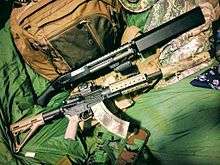
Apart from integral silencers which are integrated as a part of the firearm's barrel, most suppressors have a "female" threaded end, which attaches to "male" threads cut into the exterior of the barrel. These types of silencers are mostly used on handguns and rifles chambered in .22LR. More powerful rifles may use this type of attachment, but harsh recoil may cause the suppressor to over-tighten to the barrel and the suppressor can become difficult to remove.[31] SilencerCo's Salvo silencer for shotguns attaches via internal barrel threading normally used to mount removable chokes.[34]
Military rifles such as the M16 or M14 often use "quick-detach" suppressors which use coarser than normal threads and are installed over an existing muzzle device such as a flash suppressor and may include a secondary locking mechanism to allow the shooter to quickly and safely add or remove a sound suppressor based on individual needs.[31]
Advanced types
In addition to containing and slowly releasing the gas pressure associated with muzzle blast or reducing pressure through the use of coolant mediums, advanced silencer designs attempt to modify the properties of the sound waves generated by the muzzle blast. In these designs, effects known as frequency shifting and phase cancellation (or destructive interference) are used in an attempt to make the suppressor quieter. These effects are achieved by separating the flow of gases and causing them to collide with each other or by venting them through precision-made holes. The intended effect of frequency shifting is to shift audible sound waves frequencies into ultrasound (above 20 kHz), beyond the range of human hearing. The Russian AN-94 assault rifle has a muzzle attachment that claims apparent noise reduction by venting some gases through a "dog-whistle" type channel. Phase cancellation occurs when similar sound waves encounter each other 180° out of phase, cancelling the amplitude of the wave and eliminating the pressure variations perceived as sound.
An alternate method under development is called the anti-phase destructive interference generator. The process involves duplication of the sound waves generated by the muzzle blast, which are then used to create an anti-phase auditory signal. Currently, this is a muzzle attached device, and is only being tested to cancel out the gunshot sound of the firearm. The devices tested incorporate multiple microphones, speakers and an auditory processor. The first shot fired is recorded, and then played back precisely out of sync(180 degrees out of phase) with each subsequent shot. This has proven successful with small caliber(.17-.22) rifles, but the amplitude has not been matched efficiently with larger cartridges. With the use of subsonic ammunition, the resultant sound waves effectively cancel each other out, and with the exception of the sound of the action cycling, completely eliminate any gunshot sound. In the current development stage, this has worked only in close proximity to the shooter, and the pressure wave(p-wave) can still be felt. Each time a different type of ammunition or firearm is used, the device needs recalibration.
Taking advantage of either property requires that the silencer be designed within the specification of the muzzle blast in mind. For example, the velocity of the sound waves is a major factor. This figure can change significantly between different cartridges and barrel lengths.
However, these concepts are controversial because a muzzle blast creates broadband noise rather than pure tones, and phase cancellation in particular is therefore extremely difficult (if not impossible) to achieve. Some suppressor manufacturers claim to use phase cancellation in their designs.[35]
From a physics standpoint, supersonic cartridge loads are impractical to suppress past the levels that are merely hearing-safe for the shooter due to the sonic boom emitted by the bullet, and cartridges such as .22 LR and .45 ACP have long been recognized as the easiest to suppress even if using technology dating back to the 1940s.[36][37]
Captive-piston silencer
Another silencer technology uses a captive piston cartridge; examples are the Smith & Wesson Quiet Special Purpose Revolver (QSPR) and the Soviet and Russian PSS silent pistol,[38] OTs-38 Stechkin silent revolver and the MTs-116M suppressed sniper rifle, a 12.7mm silenced development of the 7.62mm MTs-116M.[39] The large calibre allows the bullet to be fired at subsonic speed, eliminating a major source of noise, while retaining accuracy, range, and effectiveness. All these weapons use special, very expensive, captive-piston ammunition; the QSPR used ammunition which resembled metal-cased .410-bore shotgun shells. The cartridge case internally works as a piston to trap the gases; the piston pushes the bullet, but the gases are retained in the cartridge case instead of being expelled noisily; in tests of the PSS the sound pressure level was 124.6 dB, similar to a suppressed .22 rimfire pistol.[38] The ammunition itself, rather than the weapon, is silent; in the US each individual round is considered to be a silencer, subject to regulations on silencers.[38]
Improvised silencers
Improvised silencers have been made from a variety of materials. In 2015, Los Angeles County Sheriff deputies recovered a ZB vz. 26 light machine gun with an automobile oil filter attached.[40] PVC pipes, plastic water bottles, and foam-filled pillows are also used.[41][42][43] In the United States, improvised silencers are governed by the same laws as manufactured ones.[41]
Characteristics
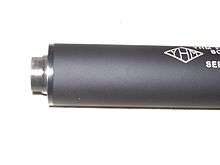
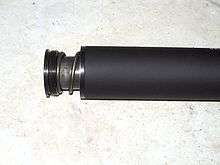
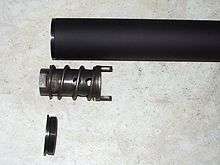

Functionally, a suppressor is meant to diminish the report of a discharged round, or make its sound unrecognizable. Other sounds emanating from the weapon remain unchanged. Even subsonic bullets make distinct sounds by their passage through the air and striking targets, and supersonic bullets produce a small sonic boom, resulting in a "ballistic crack". Semi-automatic and fully automatic firearms also make distinct noises as their actions cycle, ejecting the fired cartridge case and loading a new round.
Aside from reductions in volume, suppressors tend to alter the sound to something that is not identifiable as a gunshot.[44] This reduces or eliminates attention drawn to the shooter. A Finnish expression dating from the Winter War says that "A silencer does not make a soldier silent, but it does make him invisible."[45] Silencers are particularly useful in enclosed spaces where the sound, flash and pressure effects of a weapon being fired are amplified. Such effects may disorient the shooter, affecting situational awareness, concentration and accuracy, and can permanently damage hearing very quickly.[46]
As the suppressed sound of firing is overshadowed by ballistic crack, observers can be deceived as to the location of the shooter, often from 90 to 180 degrees from his actual location. However, counter-sniper tactics can include gunfire locators, such as the U.S. Boomerang system, where sensitive microphones are coupled to computers running algorithms, and use the ballistic crack to detect and localize the origin of the shot.
There are many advantages in using a silencer that are not related to the sound.
Hunters using centerfire rifles find silencers bring various important benefits that outweigh the extra weight and resulting change in the firearm's center of gravity. The most important advantage of a suppressor is the hearing protection for the shooter as well as their companions. Many hunters have suffered permanent hearing damage due to someone else firing a high-caliber gun too closely without warning.[47] By reducing noise, recoil and muzzle-blast, it also enables the firer to follow through calmly on their first shot and fire a further carefully aimed shot without delay if necessary. Wildlife of all kinds are often confused as to the direction of the source of a well-suppressed shot. In the field, however, the comparatively large size of a centerfire rifle suppressor can cause unwanted noise if it bumps or rubs against vegetation or rocks, so many users cover them with neoprene sleeves.[48]
Silencers reduce firing recoil significantly, primarily by diverting and trapping the propellant gas. The gas generally has much less mass than the projectile, but it exits the muzzle at multiples of the projectile velocity, so reducing the speed and quantity of the gas expelled can significantly reduce the total momentum of the matter (gas and projectile) leaving the barrel, the negation of which, because momentum is conserved, is transferred to the gun as recoil. Paulson et al., discussing low-velocity pistol calibers, suggest the recoil reduction is around 15%.[27]:38–40 With high-velocity calibers, recoil reduction runs in the range of 20–30%.[49] The added mass of the suppressor—normally 300 to 500 grams—also helps to manage the recoil.
A suppressor also cools the hot gases coming out of the barrel enough that most of the lead-laced vapor that leaves the barrel condenses inside the silencer, reducing the amount of lead that might be inhaled by the shooter and others around them. However, in auto-loading actions this might be offset by increased back pressure, which results in propellant gas blowing back into a shooter's face through the chamber during case ejection.[50]
Subsonic ammunition
In weapons firing supersonic ammunition, the bullet itself produces a loud and very sharp sound as it leaves the muzzle in excess of the speed of sound and gradually reducing speed as it travels downrange. This is a small sonic boom, and is referred to in the firearm field as "ballistic crack" or "sonic signature". Subsonic ammunition eliminates this sound, but at the cost of lower velocity, resulting in decreased range and much decreased muzzle energy unless the bullet weight is increased, thus lessening effectiveness on the target. For example, if the muzzle velocity is reduced from 2,700 ft/s (820 m/s) (common for the .308 Winchester, for example) to a subsonic 950 ft/s (290 m/s), the muzzle energy is reduced by a factor of 8. Military marksmen and police units may use subsonic ammunition in suppressed rifles, when minimal noise is more important than range and energy.[51]
However, the numeric effectiveness of subsonic rounds is, again, misrepresented by media.[32] Independent testing of commercially available firearm suppressors with commercially available subsonic rounds has found that .308 subsonic rounds decreased the volume at the muzzle by 10 to 12 dB when compared to the same caliber of suppressed supersonic ammunition.[52] When combined with silencers, the subsonic .308 rounds metered between 121 and 137 dB.
The ballistic crack depends on the speed of sound, which in turn depends mainly on air temperature. At sea level, an ambient temperature of 70 °F (21 °C), and under normal atmospheric conditions, the speed of sound is approximately 1,140 feet per second (350 m/s). Bullets that travel near the speed of sound are considered transonic, which means that the airflow over the surface of the bullet, which at points travels faster than the bullet itself, can break the speed of sound. Pointed bullets, which gradually displace air, can get closer to the speed of sound than round- or snub-nosed bullets before becoming transonic.
Special cartridges have been developed for use with a silencer. These cartridges use very heavy bullets to make up for the energy lost by keeping the bullet subsonic. A good example of this is the .300 Whisper cartridge, which is formed from a necked-up .221 Remington Fireball cartridge case. The subsonic .300 Whisper fires up to a 250 grains (16 g), .30 caliber bullet at about 980 feet per second (300 m/s), generating about 533 foot-pounds force (723 J) of energy at the muzzle. While this is similar to the energy available from the .45 ACP pistol cartridge, the reduced diameter and streamlined shape of the heavy .30 caliber bullet provides far better external ballistic performance, improving range substantially.
9×19 mm Parabellum, a very popular caliber for suppressed shooting, can use almost any factory-loaded 147 grains (9.5 g) weight round to achieve subsonic performance. These 147 gr weight bullets typically have a velocity of 900–980 feet per second (270–300 m/s), which is less than the 1,140 feet per second (350 m/s) speed of sound.[53]
.jpg)
The Soviet/Russian armor-piercing 9×39mm ammunition used in rifles such as the AS Val has a high subsonic ballistic coefficient, high retained downrange energy, high sectional density, and moderate recoil.[54]
Without using subsonic ammunition, the muzzle velocity of a supersonic bullet can be lowered by other means, before it leaves the barrel. Some silencer designs, referred to as "integrals", do this by allowing gas to bleed off along the length of the barrel before the projectile exits. The MP5SD is an example of this, with holes right after the chamber of the barrel used to reduce a regular 115 or 124 gr ammunition to subsonic velocities.[28]
Effectiveness
Live tests by independent reviewers of numerous commercially available suppressors find that even low-power, unsuppressed .22 LR handguns produce gunshots over 160 decibels.[52] A recent study of various suppressors reported peak sound pressure level reductions between 17 dB and 24 dB.[55] Another study evaluated two calibers of rifle and nine suppressors, .223 caliber AR-15 (five suppressors) and .300 caliber AAC Blackout (four suppressors), and reported noise reduction of the peak sound level pressure between 7 dB and 32 dB.[56] The De Lisle carbine, a British World War II suppressed rifle used in small numbers by Special Forces, was recorded at 85.5 dB in official firing tests.[57]
Comparatively, ear protection commonly used while shooting provides 18 to 32 dB of sound reduction at the ear.[58] Further, chainsaws, rock concerts, rocket engines, pneumatic drills, small firecrackers, and ambulance sirens are rated at 100 to 140 dB.[59]
While some consider the noise reduction of a suppressor significant enough to permit safe shooting without hearing protection ("hearing safe"), noise-induced hearing loss may occur at 85 time-weighted-average decibels or above if exposed for a prolonged period,[60] and suppressed gunshots regularly meter above 130 dB. However, the U.S. Occupational Safety and Health Administration uses 140 dB as the "safety cutoff" for impulsive noise, which has led most U.S. manufacturers to advertise sub-140 dB silencers as "hearing safe". Current OSHA standards would allow no more than sub-single-second exposure to impact noise over 130 dB per 24 hours. That would equate to a single .308 round fired through a very efficient suppressor. This result effectively requires all users of silencers to wear additional ear protection.
Decibel testing measures only the peak sound "pressure" noise, not duration or frequency. Limitations of dB testing become apparent in a comparison of sound between a .308 caliber rifle and a .300 Winchester Magnum rifle. The dB meter will show that both rifles produce the same decibel level of noise. Upon firing these rifles, however, it is clear that the .300 Winchester Magnum sounds much louder. What a dB meter does not show is that, although both rifles produce the same peak sound pressure level (SPL), the .300 Winchester Magnum holds its peak duration longer—meaning that the .300 Winchester Magnum sound remains at full value longer, while the .308 peaks and falls off more quickly. Decibel meters fail in this and other regards when being used as the principal means to determine silencer capability. In a physical sense, dB meters essentially take a short-time average (RMS intensity of a sonic signal or impulse) over a specified period of time (sampling rate), and do not take into account the rate of increase of the sound wave packet (first derivative of packet envelope), which would in practice provide a better sense of the human perception of sound.[61]
Alan C. Paulson, of Paladin Press, writes that suppressors are considered a great help, along with hearing protection, to preserve the hearing of the user and any onlookers.[62]
Regulation
Legal regulation of silencers varies widely around the world. In some nations, such as Finland, France, and New Zealand some or all types of suppressor are essentially unregulated and are sold through retail stores or by mail-order.[32] In other countries their possession or use is more restricted.
Europe
- In Norway, silencers are not regulated and can be purchased by anyone for any firearm. No licence or permit is necessary.[63]
- In Denmark, the Danish Weapons And Explosives Law makes the unlicensed possession of a silencer illegal. As of 7 May 2014 it is legal to own and use silencers for hunting.[64]
- In Finland, a firearm silencer is classified as a firearm part by law. Purchasing a suppressor requires a firearm ownership permit, which must be shown to the vendor at the moment of purchase.[65]
- Silencers for rimfire pistols are sold without government oversight in France.[32]
- Poland: In 2020 new amendment to Arms and Ammunition Act allowed police to issue permits for firearms with sound suppressors for hunting permits. Hunters are allowed to use them only for sanitary shooting of animals.[66]
- In the Russian Federation, using firearm silencers (legally defined as "devices for noiseless shooting") by civilians is prohibited, and dealers are prohibited from selling them, but there is no penalty for purchasing or possession of such devices.[67]
- In Sweden, silencers for specified calibers are legal for hunting purposes; a license is required.[27]:9
- In the UK, the owner's firearm certificate (FAC) will need to show permission for the purchase of a "sound moderator" and also the firearm for which it is intended. All firearms certificates have the firearm and caliber approved by the police and annotated to the document before a silencer may be purchased. Applicants must show a "good reason" for needing the accessory.[68]
- In Germany, a silencer is treated the same in the eyes of the law as the weapon it is designed for. Accordingly, suppressors for air guns, which can be purchased by anyone over 18 years of age, can as well be purchased by anyone over 18. Since, amongst other things, "good cause" must be shown to be issued a license to own a firearm in Germany, the same "good cause" requirement exists for suppressors for these firearms. This requirement is handled very varyingly across the States of Germany. The State of Bavaria accepts the possession of a valid hunter's license as "good cause" to own an unlimited number of suppressors, while North Rhine-Westphalia does not accept hunting as a "good cause" at all. Baden-Württemberg accepts "active exercise of hunting" as "good cause", but only allows the purchase of one silencer.[69]
- In Italy, a silencer is considered a restricted firearms accessory, allowed only to the armed forces, police and government agency.. The exception to this are any silencers acquired before 4 November 2013, where these items can be freely retained and used. No registration is needed for these. [70]
- In the Czech Republic, a silencer is considered a prohibited firearms accessory, and as such can only be obtained with an extremely uncommon exception for weapon collectors.[71]
North America
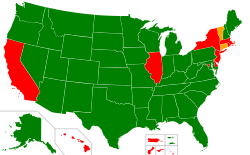
- In Canada, a device to muffle or stop the sound of a firearm is a "prohibited device" under the Criminal Code.[72] A prohibited device is not inherently illegal in Canada but it does require an uncommon and very specific prohibited device license for its possession, use, and transport. Silencers cannot be imported into the country by civilians.[73] See Gun politics in Canada
- In the United States, taxes and strict regulations affect the manufacture and sale of silencers under the National Firearms Act. They are legal for individuals to possess and use for lawful purposes in 42 of the 50 states. However, a prospective owner must go through an application process administered by the Bureau of Alcohol, Tobacco, Firearms and Explosives (ATF), which requires a federal tax payment of $200 and a thorough criminal background check. The tax payment buys a revenue stamp, which is the legal document allowing possession of a suppressor. The eight states that have explicitly banned any civilian from possessing a suppressor are: California, Delaware, Hawaii, Illinois, Massachusetts, New Jersey, New York, Rhode Island,[74] and the District of Columbia. The states of Connecticut and Vermont allow suppressor ownership, but prohibit using silencers while hunting.[75] The federal legal requirements to manufacture a suppressor in the United States are enumerated in Title 26, Chapter 53 of the United States Code.[76] Individual states and several municipalities also have their specific requirements. Federal law provides severe penalties for crimes of violence committed using firearms equipped with silencers, with a minimum prison sentence of 30 years.[77][78]
Oceania
- In Australia, use and ownership of silencers is generally limited to government, security and law enforcement use only and thus prohibited for civilians.
- In New Zealand, following firearm law changes in April 2019, suppressors could still be fitted to a standard firearm.[79]
See also
- Notable suppressed firearms:
De Lisle carbine, MAC-10, MSP Groza silent pistol, OTs-38 Stechkin silent revolver, PBS-1 Suppressor, STEN mk II VSS Vintorez, Welrod,
- Title II weapons
- Piston effect § Tunnel boom, for a similar device but far bigger, on ends of railway tunnels
- Sound blimp, a device to reduce the noise made by a camera's shutter
Other muzzle devices
References
- "Firearms - Gun Control Act Definition - Silencer". atf.gov. atf.gov. Retrieved 6 February 2017.
- "US Patent 958935 - Google Patents".
- Crossman, Edward (1923). Popular Science (ed.). "Maxim's House of Silence". 100 (2). Bonnier Corporation: 48. ISSN 0161-7370. Cite journal requires
|journal=(help) - USAR, William S. Brophy (1 May 1989). Marlin Firearms: A History of the Guns and the Company That Made Them. Stackpole Books. p. 653. ISBN 978-0-8117-4694-6.
During the early 1900s, Hiram Percy Maxim designed and patented gun silencers. His efforts were directed toward both military and sporting arms and resulted in his forming the Maxim Silencer Company, Hartford, Conn.
- Freeman, Morton S. (18 December 1997). A New Dictionary of Eponyms. Oxford University Press, USA. p. 165. ISBN 978-0-19-509354-4.
- Gage (1913). Electrical Record and Buyer's Reference. New York: Buyers' Reference Company. p. 53.
- Goddard, Stephen B. (11 November 2000). Colonel Albert Pope and His American Dream Machines: The Life and Times of a Bicycle Tycoon Turned Automotive Pioneer. McFarland. p. 227. ISBN 978-1-4766-1334-5.
- Boorman, Dean K. (2001). The History of Winchester Firearms. Globe Pequot Press. p. 74. ISBN 978-1-58574-307-0.
- Stanley Lovell (1963), Of Spies and Stratagems, Englewood Cliffs, NJ: Prentice-Hall. Lovell claimed that a weapon so quiet would be more efficient than any death ray.
- Kessler, Ronald (1994). Inside the CIA. New York: Simon and Schuster. p. 187. ISBN 978-0-671-73458-9.
- Bull, Stephen (1 January 2004). Encyclopedia of Military Technology and Innovation. Greenwood Publishing Group. p. 237. ISBN 978-1-57356-557-8.
- Section 1(a), Public Law No. 474, Ch. 757, 48 Stat. 1236 (June 26, 1934).
- "Bureau of Alcohol, Tobacco, Firearms and Explosives, Silencer FAQ". Retrieved 2011-03-22.
- Greener, W. W. (1 October 2002). The Gun and Its Development. Lyons Press. p. 9. ISBN 978-1-58574-734-4.
- US 4530417
- "Five sound moderators on test - Shooting UK". Shooting UK. 2016-12-21. Retrieved 2018-04-11.
- The NRA Handbook Including The NRA Rules Of Shooting and the Programme of the Imperial Meeting Friday 17 June To Saturday 23 July 2016 (PDF), National Rifle Association of the United Kingdom, March 26, 2016
- "silencer". Oxford English Dictionary (3rd ed.). Oxford University Press. September 2005. (Subscription or UK public library membership required.)
- "suppressor". Oxford English Dictionary (3rd ed.). Oxford University Press. September 2005. (Subscription or UK public library membership required.)
- "suppressor". The American Heritage Dictionary of the English Language (5th ed.). Boston: Houghton Mifflin Harcourt.
- "suppressor". Dictionary.com Unabridged. Random House. Retrieved 2018-02-24.
- LaSorte, Darren (December 22, 2011), "Suppressors: For Hearing and the Shooting Sports", American Rifleman, National Rifle Association
- Devaney, Tim (May 5, 2017), "Gun lobby seeks to calm fears about silencers", The Hill
- Examples of blaming Hollywood exaggeration of silencer effectiveness:
- Sweeney, Patrick (February 10, 2017), "Ruger silent-SR: One of the great names in firearms takes the plunge into a once-taboo market", Firearms News, Outdoor Sportsman Group – via General OneFile (subscription required) , pp. 32+,
With subsonic ammunition, the Silent-SR provided the Hollywood 'phuut-phuut' noise that all movie suppressors are supposed to deliver
- McCombie, Brian (August 28, 2014), "Joshua Waldron: how two guys in a rock band redesigned silencers and became the biggest suppressor maker in the nation", Gun Digest, Gun Digest Books – via General OneFile (subscription required) , pp. 48+[Joshua Waldron, co-founder of SilencerCo] "So I see a big part of my job as educating the public about silencers and trying to undo so much of that stupid Hollywood idea about silencers being an assassin's tool.
- McCombie, Brian (June–July 2012), "Hush-up: how sound suppressors work and why you should own one", Outdoor Life, Bonnier Corporation – via General OneFile (subscription required) , p. 82,
Despite their Hollywood image, suppressors are not 'silencers.' They won't completely muffle rifle or handgun noise, and they won't stop the sonic crack of a bullet that comes from traveling beyond the speed of sound.
- "Hollywood has a lot to answer for.", National Review, E. Garrett Bewkes IV – via General OneFile (subscription required) , p. 10, February 6, 2017,
In the real world, 'silencers' are actually 'suppressors,' and they don't eliminate the sound of a gunshot so much as slightly reduce it--
- Sweeney, Patrick (February 10, 2017), "Ruger silent-SR: One of the great names in firearms takes the plunge into a once-taboo market", Firearms News, Outdoor Sportsman Group – via General OneFile (subscription required) , pp. 32+,
- Rosenwald, Michael S. (January 9, 2017), "Gun silencers are hard to buy. Donald Trump Jr. and silencer makers want to change that", The Washington Post
- Slowik, Max (May 9, 2014), ASA changes its name to American Suppressor Association
- Silencer: History and Performance, Volume 1 by Alan C. Paulson
- Brian J. Heard (17 August 2011). Handbook of Firearms and Ballistics: Examining and Interpreting Forensic Evidence. John Wiley and Sons. p. 32. ISBN 978-1-119-96477-3. Retrieved 6 January 2012.
- "Reflex Suppressor for Barrett M82A1 - BR Reflex Suppressors (Finland)". Guns.connect.fi. Retrieved 2009-03-09.
- "Suppressors - Silencers - SilencerCo". SilencerCo. Archived from the original on 2011-01-08.
- Walker, Robert E. (2013-03-21). Cartridges and Firearm Identification. Fort Myers, Florida: CRC Press. pp. 210–214, 295. ISBN 978-1-4665-8881-3.
- Dockery, Kevin (2007). Stalkers and Shooters: A History of Snipers. New York: Penguin Group US. pp. 218–235. ISBN 978-1-4406-2890-0. Retrieved 8 August 2013.
- United States, Tobacco Bureau of Alcohol, and Firearms, Firearms Programs Division, Tobacco Bureau of Alcohol, Firearms and Explosives. Federal Firearms Regulations Reference Guide. DIANE Publishing. p. 176. ISBN 978-1-4289-5186-0. Retrieved 8 August 2013.CS1 maint: multiple names: authors list (link)
- Waldron, Len. "SilencerCo Salvo 12 Gauge Suppressor Review." Guns & Ammo. March 7, 2016.
- Webb, Brandon; Doherty, Glen (15 September 2010). 21st Century Sniper: The Complete Guide. Skyhorse Publishing Inc. pp. 71–72. ISBN 978-1-61608-001-3.
- .22 and .45 as easy to suppress ammunition
- "Sound Suppressors on High-Powered Rifles". connect.fi.
- "Beyond Quiet: The Russian PSS Captive Piston Pistol (2 Web pages)". Small Arms Defense Journa. 16 August 2011. Retrieved 14 June 2019.
- David Hambling (25 August 2018). "The Science of Russia's New Silent Sniper Rifle". Popular Mechanics. Retrieved 14 June 2019.
- Weingarten, Dean (November 27, 2015). "Homeless Man's Black Market Submachine Guns and Improvised Silencer". thetruthaboutguns.com. Retrieved 12 October 2016.
- Hollenbach, George M. (1996). Workbench Silencers: The Art Of Improvised Designs. Paladin Press. ISBN 1610046773. Retrieved 12 October 2016.
- Emerson, Clint (Oct 13, 2015). 100 Deadly Skills: The SEAL Operative's Guide to Eluding Pursuers, Evading Capture, and Surviving Any Dangerous Situation. Simon and Schuster. p. 70. ISBN 978-1476796055. Retrieved 12 October 2016.
- Itabashi, Hideo H. (2011). "Injuries Due to Firearms and Other Missile-Launching Devices". Forensic Neuropathology: A Practical Review of the Fundamentals. Academic Press. p. 223. ISBN 978-0080549842.
- Dougherty, Martin J. (2012). SAS and Elite Forces Guide Sniper: Sniping Skills from the World's Elite Forces. Lyons Press. pp. 43–44. ISBN 978-0-7627-8876-7.
- Paulson, Al (2004). "Finland's Silenced .338 Long-Range Sniper:Sako TRG42 Rifle and BR-Tuote T8M Reflex Suppressor". Guns & Weapons for Law Enforcement. New York: Harris Publications. 1 (8).
- Dater, Philip; Dockery, Kevin (July 2007). "28". Stalkers and Shooters: A History of Snipers. BERKLEY Publishing Group. pp. 228–235. ISBN 978-0-425-21542-5.
- Stewart, Michael; Meinke, Deanna K.; Flamme, Gregory A.; Murphy, William J.; Finan, Donald S.; Lankford, James E.; Tasko, Stephen M. (2017). "NHCA Position Statement, Recreational Firearm Noise" (PDF). National Hearing Conservation Association.
- Mann, Richard A. (30 April 2014). Gun Digest Shooter's Guide to the AR-15. Iola, Wisconsin: Krause Publications. pp. 232–233. ISBN 978-1-4402-3847-5.
- White, Mark (1998). "The Use of Sound Suppressors on High-Powered Rifles". Small Arms Review Vol. 1 No 7-9.
- Emptormaven. "Rethinking Direct Impingement". Retrieved 4 March 2014.
- "Modern sniper rifles". world.guns.ru. 2001-01-26. Retrieved 2009-03-09.
- Silvers, Robert (2005). "Results". Retrieved 2009-03-09.
- Ayoob, Massad (28 February 2011). Gun Digest Book of Beretta Pistols. Iola, Wisconsin: Gun Digest Books. p. 223. ISBN 978-1-4402-2424-9.
- Tilstra, Russell C. (21 March 2014). The Battle Rifle: Development and Use Since World War II. McFarland. p. 165. ISBN 978-1-4766-1564-6.
- Murphy, William J.; Flamme, Gregory A.; Campbell, Adam R.; Zechmann, Edward L.; Tasko, Stephen M.; Lankford, James E.; Meinke, Deanna K.; Finan, Donald S.; Stewart, Michael (2018-01-26). "The reduction of gunshot noise and auditory risk through the use of firearm suppressors and low-velocity ammunition". International Journal of Audiology. 57 (sup1): S28–S41. doi:10.1080/14992027.2017.1407459. ISSN 1499-2027. PMID 29299940.
- Lobarinas, Edward; Scott, Ryan; Spankovich, Christopher; Prell, Colleen G. Le (2016-02-12). "Differential effects of suppressors on hazardous sound pressure levels generated by AR-15 rifles: Considerations for recreational shooters, law enforcement, and the military". International Journal of Audiology. 55 (sup1): S59–S71. doi:10.3109/14992027.2015.1122241. ISSN 1499-2027. PMID 26821935.
- Rome, Robert (June 1984). "WWII Silent Killer Still Lives" (PDF). Gung Ho: 29.
- "Firearms and Hearing Protection | March 2007 | The Hearing Industry Resource". Hearingreview.com. 2007-02-12. Retrieved 2009-03-09.
- "2.7: Decibels". Campus.murraystate.edu. Retrieved 2009-03-09. Archived April 18, 2009, at the Wayback Machine
- "nihl". Hearinglossweb.com. Retrieved 2009-03-09.
- dB in Principle and Practice, AWC Systems Technology April 2010
- Kokalis, Peter G.; Paulson, Alan C, and Parker, N.R. (2002). Silencer History and Performance, Vol 2: CQB, Assault Rifle, and Sniper Technology. Paladin Press. p. 49. ISBN 1581603231.CS1 maint: multiple names: authors list (link)
- "Forskrift om skytevåpen, våpendeler og ammunisjon mv. (Våpenforskriften) - Lovdata".
- "Bekendtgørelse om våben og ammunition der må anvendes til jagt m.v." [Hunting weapons and ammunition act]. retsinformation.dk (in Danish). Miljøministeriet. 2014-05-07. Retrieved 2015-03-15.
- Baum, Dan (2013). Gun Guys: A Road Trip. Knopf. pp. 45–46. ISBN 978-0-307-59541-6.
- "Dwie ustawy z podpisem Prezydenta". January 29, 2020.
- Carter, Gregg Lee (1 January 2002). Guns in American Society: An Encyclopedia of History, Politics, Culture, and the Law. ABC-CLIO. p. 512. ISBN 978-1-57607-268-4.
- "Sound Moderators". Durham Constabulary. Retrieved 17 September 2016.
- "Jagdrecht in Bayern" [Hunting Laws in Bavaria]. Bavarian Ministry of Agriculture (in German). Retrieved 20 January 2017.
- "Silenziatori in Italia" [Silencers in Italy]. Military Weapons (in Italian). Retrieved 25 April 2020.
- "Ministry of Interior of the Czech Republic" (in Czech).
- "Criminal Code of Canada, Part III Firearms and other Weapons". Retrieved 2012-11-20.
- "Importing a Firearm or Weapon Into Canada". Canada Border Services Agency. Retrieved 2008-06-11.
- "13 V.S.A. § 4010. Gun silencers". Retrieved March 5, 2014.
- "Education". americansuppressorassociation.com. Retrieved 2016-09-27.
- "Title 26, United States Code, Chapter 53 - Legal Information Institute, Cornell University Law School". Law.cornell.edu. 2008-09-24. Retrieved 2009-03-09.
- "Title 18, United States Code, Section 924(c)(1)(B)(ii) - Legal Information Institute, Cornell University Law School". Law.cornell.edu. 2013-02-13. Retrieved 2013-03-17.
- Clark, Paul A. "Criminal Use of Firearm Silencers" (PDF). Western Criminology Review. Retrieved 15 September 2016.
- "Firearms changes FAQs". New Zealand Police. 15 May 2019.
External links
| Wikimedia Commons has media related to Firearm silencers. |
| Wikiquote has quotations related to: Silencer (firearms) |